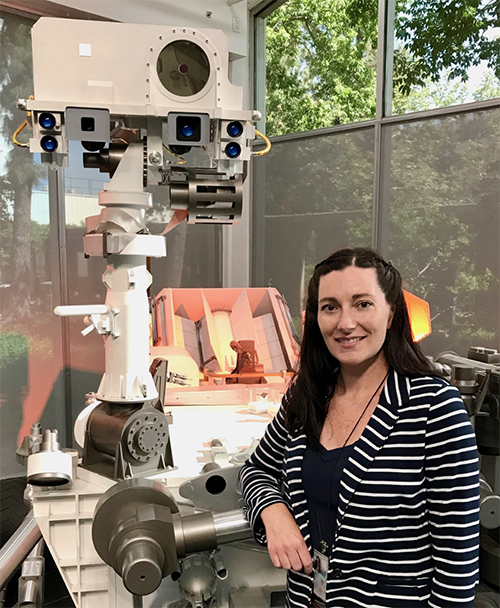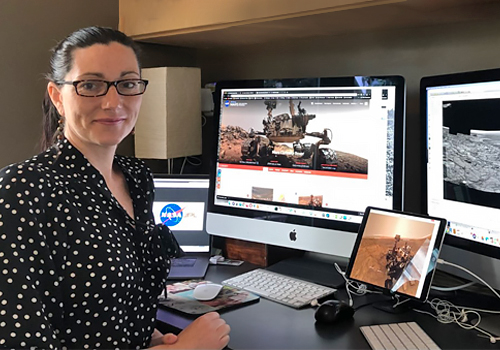Carrie Bridge’s job is out of this world, so to speak — and it all started at Arts & Science.
Her degree program at the David A. Dunlap Department of Astronomy & Astrophysics inspired and equipped her to land a role with NASA’s Jet Propulsion Laboratory (JPL) in California, where she oversees both science and engineering operations that help NASA’s spacecraft explore the solar system’s enigmatic moons and planets.
“Although I initially pursued biology as my major, stargazing was a beloved hobby of mine” recalls Bridge, who graduated with an honours bachelor of science in 2002 as a member of Victoria College. “But after taking my first astronomy class, I knew I had to switch majors — and from that point on, my passion for the subject only intensified.”

The diversity of classes at U of T helped her settle on a career path, but Bridge also remembers summer research opportunities and supportive faculty who affirmed her sky-high aspirations.
"After graduation, I felt very prepared as a researcher, and I attribute a lot of that success to Professor Ray Carlberg, who mentored me during my undergraduate degree and supervised my PhD,” says Bridge, who completed her post-doctorate in 2007.
“As an undergraduate, Bridge went to the Dupont Telescope in northern Chile to lead the observing for a joint Toronto-Carnegie project,” recalls Carlberg. “Her observations using a unique new instrument were the basis of the first measurement of a surprising number of massive old galaxies at early times in the universe.
“Later in her PhD, she examined images of thousands of close pairs of galaxies to identify signs of gravitational interaction. This marks the early stages of galaxy mergers which create massive galaxies. Her work is foundational to many current studies that today use machine learning to make similar measurements.”
Bridge then went on to Caltech for a postdoctoral fellowship studying galaxy evolution and today has multiple roles at JPL where she has been awarded the principal designation in science operations. As the deputy section manager for planning and execution systems at JPL, she oversees a team of 260 people who support the development, operations and scientific discoveries of orbiters, landers, rovers and deep space observatories.
"An integral part of my job is to stay current with the latest engineering advancements and the most intriguing scientific questions,” she says. “We must think strategically to successfully support the next generation of space missions.”

Bridge is also the science operations team chief for Curiosity, the “selfie” taking rover. In the last 10 years, Curiosity has beamed back millions of Martian landscape pictures. The spacecraft is equipped with an internal geochemical laboratory which analyzes air and soil samples in order to determine whether Mars had the ability to support life in the past.
"This morning, we executed a short seven-metre drive positioning the rover in close proximity to an interesting geological outcrop,” explains Bridge. “Since our science team is spread across seven countries, including Canada, every planning day entails a video conference with scientists from around the world. Together, we select optimal targets for the laser to determine the chemistry of the rocks and which observations and experiments are needed to understand how this region on Mars formed.”
The gravity of the situation isn’t lost on Bridge.
"It’s important to take a step back and recognize that we have the privilege of witnessing an unprecedented sight, such as a never-before-seen image of Mars or a newly discovered galaxy. It’s both awe-inspiring and humbling to explore the universe as your job.”
There are more exciting challenges on the horizon. JPL is engaged in planning a sample return lander that will collect core samples obtained by the Perseverance rover so they can be analyzed by scientists on Earth. Bridge is also intrigued by proposed voyages to Enceladus. Scientists think Saturn’s tiny, ice-encrusted moon may harbour microbial life forms in mysterious, untouched oceans many kilometres deep.
Her curiosity still burns bright, the same as it has since childhood. Years ago, she marvelled at stars and satellites with her grandfather at the family cottage on Lake Huron and pondered, if life exists elsewhere.
“It's exciting to think that microbial life may actually exist right now on other planets or moons in our very own solar system,” says Bridge. “It may just be a matter of us not having discovered it yet.”

